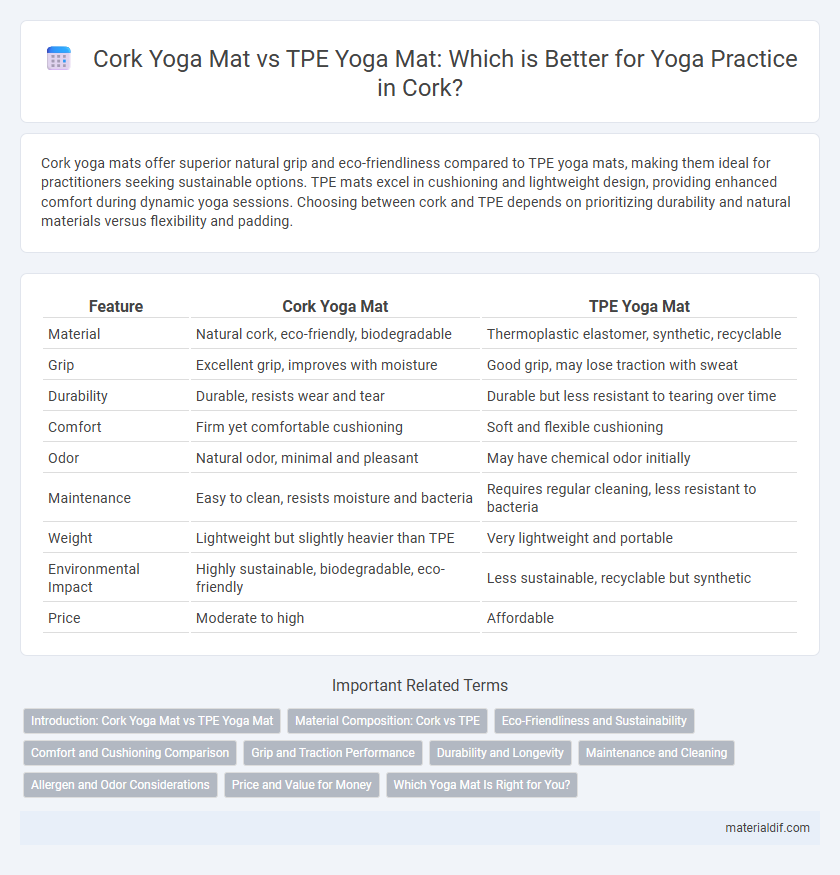Cork yoga mats offer superior natural grip and eco-friendliness compared to TPE yoga mats, making them ideal for practitioners seeking sustainable options. TPE mats excel in cushioning and lightweight design, providing enhanced comfort during dynamic yoga sessions. Choosing between cork and TPE depends on prioritizing durability and natural materials versus flexibility and padding.
Table of Comparison
| Feature | Cork Yoga Mat | TPE Yoga Mat |
|---|---|---|
| Material | Natural cork, eco-friendly, biodegradable | Thermoplastic elastomer, synthetic, recyclable |
| Grip | Excellent grip, improves with moisture | Good grip, may lose traction with sweat |
| Durability | Durable, resists wear and tear | Durable but less resistant to tearing over time |
| Comfort | Firm yet comfortable cushioning | Soft and flexible cushioning |
| Odor | Natural odor, minimal and pleasant | May have chemical odor initially |
| Maintenance | Easy to clean, resists moisture and bacteria | Requires regular cleaning, less resistant to bacteria |
| Weight | Lightweight but slightly heavier than TPE | Very lightweight and portable |
| Environmental Impact | Highly sustainable, biodegradable, eco-friendly | Less sustainable, recyclable but synthetic |
| Price | Moderate to high | Affordable |
Introduction: Cork Yoga Mat vs TPE Yoga Mat
Cork yoga mats offer a natural, eco-friendly alternative to traditional TPE yoga mats, providing superior grip and antimicrobial properties. While TPE mats are lightweight, affordable, and widely available, cork mats excel in durability and sustainability due to their renewable cork material sourced mainly from Mediterranean cork oak trees. This comparison highlights the key differences in material composition, environmental impact, and user experience for yoga practitioners seeking optimal comfort and performance.
Material Composition: Cork vs TPE
Cork yoga mats are made from natural, renewable cork harvested from cork oak trees, offering excellent grip and antimicrobial properties without synthetic chemicals. TPE yoga mats, composed of Thermoplastic Elastomers, provide a lightweight, flexible, and recyclable alternative with a soft cushioning effect but involve synthetic polymers. While cork excels in eco-friendliness and durability, TPE mats appeal for their hypoallergenic and easy-to-clean material properties.
Eco-Friendliness and Sustainability
Cork yoga mats are highly eco-friendly due to their natural, biodegradable material sourced from the renewable bark of cork oak trees, which regenerates without harming the tree. In contrast, TPE yoga mats, made from thermoplastic elastomers, offer partial recyclability but rely on synthetic polymers derived from petrochemicals, raising sustainability concerns. Cork mats also provide superior durability and antimicrobial properties, reducing the need for frequent replacements and minimizing environmental impact over time.
Comfort and Cushioning Comparison
Cork yoga mats offer exceptional comfort and cushioning due to their natural density and ability to conform to body contours, providing a firm yet supportive surface ideal for stability in poses. TPE yoga mats, crafted from thermoplastic elastomers, deliver superior shock absorption and resilience, ensuring a cushioned feel that reduces joint strain during dynamic movements. While cork mats excel in breathability and moisture-wicking properties enhancing grip and comfort, TPE mats provide lightweight flexibility and enhanced durability for long-lasting cushioning performance.
Grip and Traction Performance
Cork yoga mats offer superior grip and traction due to their natural texture and moisture-wicking properties, which improve grip during sweaty sessions. TPE yoga mats provide consistent traction with enhanced cushioning and are lightweight, making them ideal for beginners or those seeking flexible performance. Both materials deliver effective grip, but cork excels in durability and natural anti-slip qualities even when wet.
Durability and Longevity
Cork yoga mats offer superior durability due to their natural resistance to wear, moisture, and odor, making them ideal for long-term use. TPE yoga mats, while lightweight and eco-friendly, generally have a shorter lifespan as they can degrade faster with regular exposure to sweat and sun. Choosing cork ensures a sustainable and resilient mat that maintains its integrity over time, especially under frequent and intense practice sessions.
Maintenance and Cleaning
Cork yoga mats are naturally antimicrobial and repel moisture, making them easier to maintain with simple wiping and occasional air drying. TPE yoga mats require regular cleaning with mild soap and water to prevent odor and bacterial buildup due to their synthetic, moisture-retentive material. The natural properties of cork reduce the need for frequent deep cleaning compared to the more porous surface of TPE mats.
Allergen and Odor Considerations
Cork yoga mats are naturally hypoallergenic and resistant to dust mites, making them ideal for individuals with allergies or sensitive skin. In contrast, TPE yoga mats may emit a chemical odor when new, which can be irritating to allergy sufferers or those sensitive to smells. Choosing a cork mat ensures a fresher, odor-free practice environment with minimal allergen exposure.
Price and Value for Money
Cork yoga mats typically cost more than TPE mats, reflecting their natural, eco-friendly materials and durability. While TPE mats are budget-friendly and lightweight, cork mats offer better grip and longevity, providing greater value for money over time. Investing in a cork mat supports sustainability and reduces the need for frequent replacements, enhancing overall cost-effectiveness despite the higher initial price.
Which Yoga Mat Is Right for You?
Cork yoga mats provide excellent grip, natural antimicrobial properties, and eco-friendly sustainability, making them ideal for environmentally conscious practitioners who prefer a firm, non-slip surface. TPE yoga mats offer lightweight durability, superior cushioning, and easy maintenance, suited for those seeking a budget-friendly, hypoallergenic option with good shock absorption. Your choice depends on whether you prioritize natural materials and sustainability or cost-effective, lightweight comfort.
Cork Yoga Mat vs TPE Yoga Mat Infographic

 materialdif.com
materialdif.com